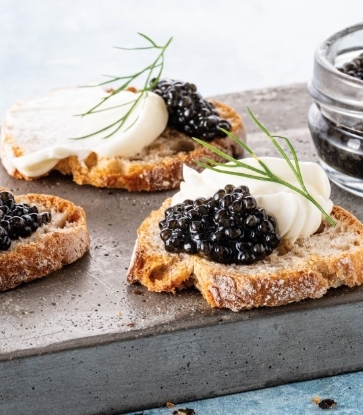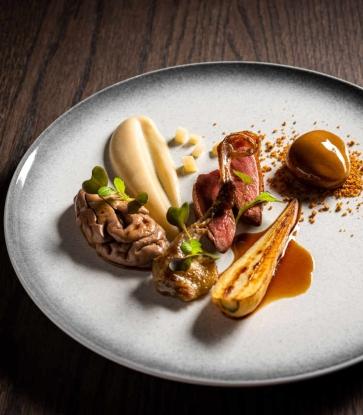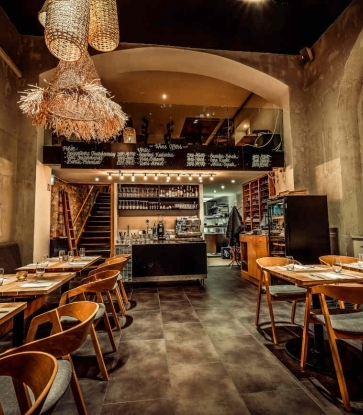Arany Kaviár : A young Research & Development chef experiments with neuroscience in gastronomy
A real Budapest classic, located in Buda, the hilly and more residential side of town, Arany Kaviár was originally founded in 1986. With the fall of the communist regime in 1989-90, the restaurant became privately owned. The original Georgian and Russian concept - featuring, of course, a lot of caviar - appealed to the Hungarians and to the tourists from the former Soviet Union. The restaurant kept its intimate charm, with its rich and heavy draperies and its secret garden. A impressive wall of excellent Hungarian and international wine bottles greets the guests as they enter.
Nowadays, a dinner at Arany Kaviár can still start with a caviar tasting, but in a fun, educational way. Guests are presented with a tray of five types of caviar, ranging from trout roe to Iranian Beluga caviar. They are kindly asked to eat each of them directly off the top of their own hand, bringing the precious sturgeon roe to the right temperature. This is only one of the many surprises at Arany Kaviár. This traditional Budapest fine-dining kitchen is actually going through a small revolution. In June 2020, José Guerrero was hired as Head of Research and Development at Arany Kaviár. Collaborating with Head Chef László Kanász, the young Columbian is a Master’s graduate in gastronomic sciences of the Basque Culinary Centre in San Sebastian (Spain). « The digital gastronomy lab was very fast-paced », he explains, « Everything we researched could become obsolete in one day ».
Not really a problem for Chef José, who is diagnosed with hyperactivity and admits that his palate is « like a rollercoaster ». Bubbling with scientifically creative ideas, he’s currently working on several research and development projects with Arany Kaviár. Teaming up with restaurant Blue Hill in New York City - which owns an R&D farm - he’s exploring the topic of farm-to-table gastronomy. He also has a project with a neuroscientist to understand the vibrations created by the brain during a meal, using eye-tracking technologies, and works on an indoor vegetable garden controlled by an app. « I want to share all of this research with Hungarian chefs », he declares, « it’s open-source knowledge ».

Though one cannot really taste technology in a dish, the creativity is palpable on each plate. As Head Chef László Kanász is originally from the Balaton Lake area, Arany Kaviár is one of the rare places in Budapest where to eat good fish and seafood, fine-dining style: lobster tail, seaweed salad with almond jelly, urchins… A wonderful starter is a Gillardeau oyster, sparked up with paprika and finger-lime. Its tiny vessels, popping in one’s mouth, bring a citrusy, tart taste to the domineering iodine flavors.
The whole dining experience is theatrical and fun. The beef tartar is created in front of you with tweezers, an entire roasted pigeon arrives in a wooden box, served with an exquisite new potato emulsion. Spoiler alert : The dessert comes in the shape of a tower hiding visually stunning sweets. A real feast for the eyes.
Nobu: the trailblazing Japanese chef is also in Budapest
World-famous Chef Nobuyuki Matsuhisa, byname Nobu, is at the head of an empire of 47 restaurants all over the world, co-owned with no less than actor Robert de Niro. The man who revolutionized Japanese cuisine by mixing it with Peruvian ingredients, making it easier to understand for many Westerners, opened Budapest’s Nobu in 2010 in the bustling city center. The restaurant itself is vibrant, with a large sushi bar and many round tables around which groups of friends or colleagues like to gather. « It’s not the right place to bring someone on a first date », Chef Gábor Schreiner says with a smile. « People come here to party, to share food and have
drinks ».

Chef Gábor Schreiner is at the head of the kitchen. Though Hungarian, he is Japanese-trained. After attending a cooking school in Budapest, he worked at a French restaurant on the Buda side of the city. The owner of a restaurant called Fuji, a Japanese woman, then hired him as a cook. After his first day in the kitchen, he was expected to know all of the ingredients and all of the orders on the menu in Japanese. « I wanted to quit », he recalls, « but the head chef encouraged me to push myself to my limit. Then I fell in love with Japanese cuisine. Deeply. It was a really authentic Japanese restaurant, and I noticed it when I visited Japan, seven years later.»
One day, during a stay in Italy, Chef Gábor bought a copy of Nobu’s cooking book. It was in Italian language, and he could not understand a word, but Nobu’s twist on Japanese cuisine literally stunned him. It was almost heretic, brilliant and bold. « I really cherished that book », remembers Chef Gábor. Then, one day, Nobuyuki Matsuhisa asked him to be the head chef at his new restaurant in Budapest. « I believe that most things in life are led by fate », he concludes.

Hungarian ingredients don’t mix really well with Japanese cuisine. Chef Gábor tried to include Hungarian freshwater fish in the menu, yet Nobu’s guests are expecting seafood. Like every other Nobu restaurant in the world, the Budapest kitchen follows the strict cooking etiquette elaborated by Nobuyuki Matsuhisa. « The sushi rice must be prepared to perfection and the quality of the fish must be impeccable », Chef Gábor emphasizes.
The Japanese are extremely protective of their culinary traditions ; their flavors are straightforward and clean. In Japan, one would never put jalapeño and garlic on raw yellowtail. The miso black cod, Nobu’s world-famous signature dish, is traditionally made with mackerel. One sashimi on the menu mixes foie gras (!) and raw salmon. The edamame, which should only be steamed with salt, are generously sprinkled with sesame and chili pepper. Yes, Nobu’s culinary style is a blasphemy… and everyone loves it !

MÁK: Hungarian terroir and Scandinavian fine-dining influences, far away from the hype
MÁK is an airy, artsy looking restaurant, featuring light wood tones, white paint on brick walls and sober decorations of dried poppies hanging over an elegantly designed bar. It feels young, chic, unfussy. Just like the plates of 30 year-old Chef János Mizsei, who are as surprising, whimsical in taste as they are clean and elegant in presentation.Trying to come up with very creative, yet easy-to-understand dishes is Chef János’ mission. He took over the kitchen in 2012, only two years after MÁK’s first opening. Betting on such a young talent was a bold move from MÁK’s owners, but it paid off. « Being from the youngest generation of cooks was a blessing », he explains. « I’m glad I did not go to cooking school at the time where the old communist culinary traditions were still prevailing. When I started studying, the Hungarian fine-dining scene was evolving massively ».
The young man learned « how to cook with passion » with his grandmother when he was 16. The old lady owned a small farm 30 kilometers away from Budapest, where she kept animals and grew an herb and vegetable garden. She taught him how to ferment produce, an old technique to preserve food during the long and harsh Hungarian winters. No wonder, then, that the young man later found himself in awe of Scandinavian fine-dining cooking techniques and their fermented flavors.

Strongly influenced by modern Scandinavian cuisine, Chef János is not trying to offer « Hungarian traditions with a twist, because everyone else is doing that right now ». Yet he draws a lot of his inspiration from the Hungarian terroir and from what he calls the « clean and pure taste of Hungarian cuisine ». To him, respecting the ingredient is everything. « It has to be surprising. Sometimes, when I create a dish, people think the ingredients on the plate will never match. But they do ! ». His smoked carrot dish, served with pike caviar, horseradish and apple, is an example of the unusual, yet balanced combinations he is proud of. MÁK also offers one of the widest ranges of natural, biodynamic wines in a Budapest restaurant, « because they are brave wines, just like our food », as Gábor Koltai, one of the owners, emphasizes.
MÁK’s cuisine is earthy, oxydized, mineral, racy. In a word, it’s captivating. « I want to initiate emotions on a plate, I want the guests to feel our positive and warm vibe », Chef János says behind his mask, his eyes narrowed in a bright smile. The Hungarian sterlet is served with a combination of cucumber softened by squash, spiced up with fermented garlic. A fabulous seared foie gras meets the unexpected back-tone of anise of the chervil herb. Tangerine peel gives a tingly kick to a beef tartar. Vegan and vegetarian options are available as well. « I love cooking vegetables because they are much more demanding than meat or fish », Chef János adds.
One should not leave the restaurant without trying a dessert designed by Barbara Hucker, the young pastry chef, who likes to create sweets with an edge of sourness. Her malt, cocoa bean, and plum creation is a must-have. The perfect finishing touch for a real foodie experience at MÁK.
Hero Image : Arany Kaviar



















